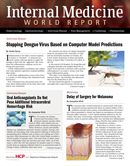Hospital Ward Antibiotic Use Associated with Infections
A team of investigators from the University of Toronto and McGill University discovered a correlation between hospital ward antibiotic prescriptions and Clostridium (C) difficile infections.

A team of investigators from the University of Toronto and McGill University discovered a correlation between hospital ward antibiotic prescriptions and Clostridium (C) difficile infections.
Analyzing the data of 16 wards over a 46-month period, the researchers included 34,298 patients who had an acute care hospital stay lasting over 2 days from the period of June 1, 2010, through March 31, 2014.
Reported in JAMA Internal Medicine, the authors saw 255 were infected during the study period (incidence rate, 5.95 per 10,000 patient-days; 95% CI, 5.26-6.73), with antibiotic use ranging from 21.7 to 56.4 days of therapy per 100 patient-days. Subsequently, the researchers determined for every 10% increase in ward-level antibiotic exposure, there was a 2.1 per 10,000 (P < .001) rise in C difficile infections.
Furthermore, they noted that the rates of C difficile incidence and ward antibiotic exposure were stagnant regardless of the patients’ recent exposure to antibiotics.
The authors, who touted their study as the first to draw a comparison between ward-level antibiotic exposure and C difficile infections, believed the increase in antibiotic exposure was caused by more patients carrying and transmitting C difficile in wards that widely use antibiotics, thus increasing environmental contamination of the bacteria. Supporting this premise, they cited evidence, which showed that half of C difficile strains in hospitals could not be linked to previously identified symptomatic patients.
Pressing for a widespread adaptation of antibiotic stewardship programs in hospitals, the authors wrote, “Future studies of C difficile infection etiology should seek to quantify patient, ward, and airborne contamination with C difficile spores to more clearly describe the mechanisms that link ward-level antimicrobial use and infection incidence.”
